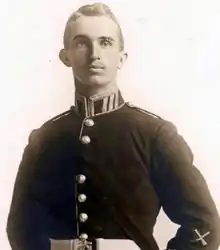Alexis Helmer
Alexis Hannum Helmer (b 29 June 1892, Hull, Quebec, Canada - d 2 May 1915, Ypres, Belgium) was killed in battle during the Great War while serving with the 2nd Battery, 1st Brigade, Canadian Field Artillery. He is known as being part of the inspiration for In Flanders Fields through his friendship with John McCrae.
Alexis Helmer | |
|---|---|
 No. 841 Lieutenant Alexis Helmer, of the RMC Class of 1912 | |
| Birth name | Alexis Hannum Helmer |
| Born | 29 June 1892 Hull, Quebec, Canada |
| Died | 2 May 1915 (aged 22) Ypres, Belgium |
| Allegiance | Canada |
| Service/ | Canadian Expeditionary Force |
| Years of service | 1912–1915 |
| Rank | Lieutenant |
| Battles/wars | First World War |
Life
He was born 29 June 1892, Hull, Quebec, Canada,[1] the son of Brigadier General R. A. Helmer and Elizabeth I. Helmer, of Gilmour Street, Ottawa, Ontario, Canada.[2]
He attended Ottawa Collegiate Institute, a high school in Ottawa, Ontario. He was later an engineer.[1]
Great War and death
He enlisted August 27, 1914 in the Canadian Field Artillery.[1]
He was killed in the Second Battle of Ypres on 2 May 1915.[2] From the Canadian Virtual War Memorial:[2]
- "The following circumstances of his death have been compiled from letters received by Lieut Owen Carsley Frederic Hague's father, Frederic Hague from officers in the area at the time. Early on Sunday morning, May 2, 1915 Lieutenants' Hague and Helmer left their position to check on a Canadian Battery who had positioned themselves on the bank of the Yser Canal near St. Julien close to the France-Belgium border. They had only gone a few yards when a six inch, high explosive canon shell burst. Lieutenant Helmer was killed instantly."
In Flanders Fields
"In Flanders Fields" is a war poem in the form of a rondeau, written during the First World War by Canadian physician Lieutenant-Colonel John McCrae. He was inspired to write it on May 3, 1915, after presiding over the funeral of friend and fellow soldier Lieutenant Alexis Helmer, at which time he noted how poppies quickly grew around the graves of those who died at Ypres. The next day, he composed the poem while sitting in the back of an ambulance at an Advanced Dressing Station outside Ypres.[3] This location is today known as the John McCrae Memorial Site.
Cyril Allinson was a sergeant major in McCrae's unit. While delivering the brigade's mail, he watched McCrae as he worked on the poem, noting that McCrae's eyes periodically returned to Helmer's grave as he wrote. When handed the notepad, Allinson read the poem and was so moved he immediately committed it to memory. He described it as being "almost an exact description of the scene in front of us both".[4] According to legend, McCrae was not satisfied with his work. It is said he crumpled the paper and threw it away.[5] It was retrieved by a fellow member of his unit, either Edward Morrison or J. M. Elder,[6] or Allinson.[5] McCrae was convinced to submit the poem for publication.[7] An early copy of the poem is found in the diary of Clare Gass, who was serving with McCrae as a battlefield nurse, in an entry dated October 30, 1915—nearly six weeks before the poem's first publication in the magazine Punch on December 8, 1915.[8]
Another story of the poem's origin claimed that Helmer's funeral was held on the morning of May 2, after which McCrae wrote the poem in 20 minutes. A third claim, by Morrison, was that McCrae worked on the poem as time allowed between arrivals of wounded soldiers in need of medical attention.[9] Regardless of its true origin, McCrae worked on the poem for months before considering it ready for publication.[10] He submitted it to The Spectator in London but it was rejected. It was then sent to Punch, where it was published on December 8, 1915.[7] It was published anonymously, but Punch attributed the poem to McCrae in its year-end index.[11]
Memorial
A memorial is dedicated to the memory of Lieutenant Alexis Hannum Helmer who was killed in action during the Great War and was part of the inspiration for In Flanders Fields in the Memorial Hall of his high school alma mater Lisgar Collegiate Institute in Ottawa, Ontario. Unveiled in 2001, the plaque was erected by the Lisgar Alumni Association.[12]
He is also memorialised on Panel 10 of The Menin Gate Memorial.[2]
Commemorated on Page 18 of the First World War Book of Remembrance in the Peace Tower, Ottawa, Ontario, Canada.[2]
References
- http://www.canadiangreatwarproject.com/searches/soldierDetail.asp?ID=56377
- http://www.veterans.gc.ca/eng/remembrance/memorials/canadian-virtual-war-memorial/detail/1592956
- Gillmor 2001, p. 93
- "Poem depicts war scenes", Regina Leader-Post, p. 13, 1968-11-12, retrieved 2012-02-07
- "Forever there... In Flanders Fields", The Journal Opinion, p. 8, 2006-03-29, retrieved 2012-02-07
- The Red Poppy, The Australian Army, archived from the original on February 26, 2012, retrieved February 7, 2012
- Prescott 1985, p. 96
- "Clare Gass Fonds". McGill Library Archival Catalogue. Retrieved 2018-02-22.
- Prescott 1985, pp. 95–96
- Gillmor 2001, p. 94
- Prescott 1985, p. 105
- "Helmer memorial: Memorial Hall, Lisgar Collegiate Institute: Memorial 35059-169 Ottawa, ON". National Inventory of Canadian Military Memorials. Veterans Affairs Canada. Retrieved 31 December 2016.